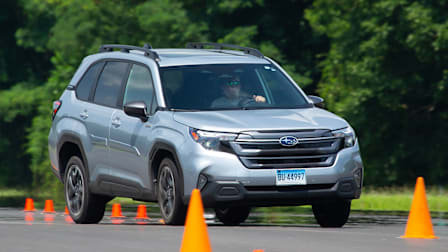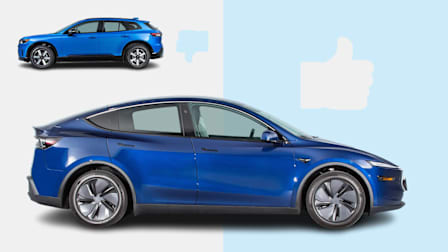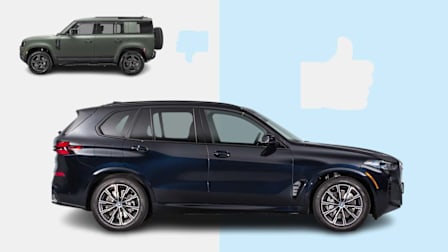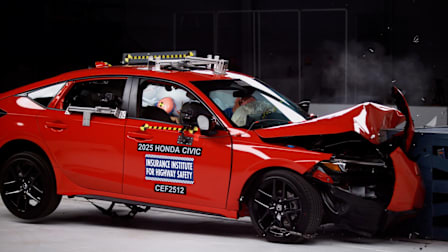Brake Lights Can Fail to Provide Fair Warning on Some Electric Vehicles
Consumer Reports' tests discover potential safety issues with brake lights on EVs from Genesis, Hyundai, Kia, and Mercedes-Benz
June 26, 2023, update: Since this article originally published June 9, 2023, Hyundai/Genesis and Kia have responded to Consumer Reports’ test findings, indicating that the companies are working on a solution to be deployed to Hyundai, Genesis, and Kia EVs this summer. The article has been updated to reflect their responses.
Thousands of electric vehicles on America’s roads could have a potentially serious safety issue: Brake lights that might not illuminate when the vehicle is brought to a stop while using aggressive regenerative-braking settings. Regenerative braking slows an EV when it’s coasting or braking while recouping energy and sending it back to recharge the battery.
Many EVs can be set to such an aggressive level of regenerative braking—often referred to as one-pedal driving—that the vehicle will rapidly slow and even come to a full stop without the driver ever having to step on the physical brake pedal. Pressing on the EV’s accelerator pedal makes the vehicle go faster, just like in conventional cars, but easing even just slightly off the accelerator pedal can start slowing the vehicle down so rapidly that it is similar to stepping on the brake pedal in a regular vehicle. Many drivers who utilize the one-pedal-driving feature maintain a light pressure on the accelerator pedal even when they are slowing the vehicle down, which makes for smoother transitions between accelerating and decelerating.
After evaluating more than a dozen EVs in our fleet, Consumer Reports’ testing shows that the brake lights on some EVs from Hyundai, Kia, and Genesis do not illuminate as the car rapidly decelerates during one-pedal driving—that is, unless the driver takes their foot fully off the accelerator pedal. This means that vehicles following one of these EVs may have no warning that it is quickly slowing down. The other EVs we tested did illuminate their brake lights, underscoring that the technology exists to prevent any confusion for the drivers following these EVs in this regen-braking mode. (See another issue with Mercedes-Benz cars, below.)
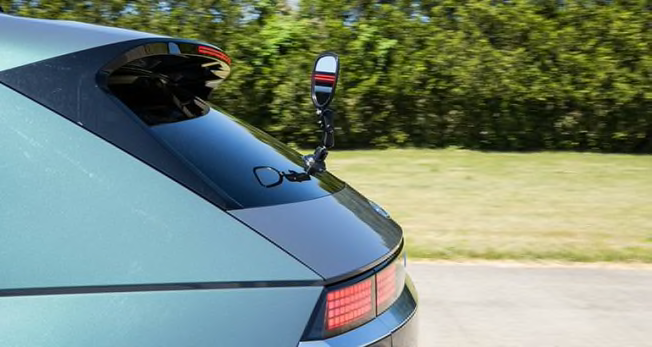
Photo: John Powers/Consumer Reports Photo: John Powers/Consumer Reports
CR's Tests Raise Concerns
Following up on the report of the Ioniq 5, CR’s team of auto experts tested the brake-light behavior on each of the 24 EVs in our own fleet (all purchased for our auto-test program) to see how widespread this issue might be across brands and models.
CR’s engineers measured how quickly each car slowed down when using the vehicles’ one-pedal-driving regenerative-braking modes, and observed at what rate of deceleration each vehicle’s brake lights came on. “On average, we found that the brake lights of most EVs in our fleet illuminate when the regenerative braking system is slowing the car at about 0.1 g (g-force), which could be described as a slight but noticeable amount of braking force,” says Alex Knizek, CR’s manager of auto testing and insights. “We think that is a level of deceleration that warrants informing other drivers via the car’s brake lights.”
While most of the EVs in CR’s fleet did illuminate their brake lights appropriately during aggressive regenerative braking, several of them did not, even when deceleration levels were considered more aggressive. Those include:
- 2022 Hyundai Ioniq 5 SEL AWD
- 2023 Genesis GV60 Advanced
- 2023 Genesis Electrified GV70
- 2022 Kia EV6 Wind AWD
- 2023 Kia Niro EV Wind
This potentially dangerous issue doesn’t exist on CR’s 2023 Hyundai Ioniq 6 SEL AWD test vehicle, as it operated consistently with proper brake-light illumination when slowing the vehicle in its i-Pedal mode, even if the driver maintained some pressure on the accelerator pedal.
Until this issue is remedied, drivers of the affected EVs should stick with the Level 1 or Level 2 regenerative-braking modes and avoid using the stronger Level 3 and strongest i-Pedal modes.
Director of Operations at the Consumer Reports Auto Test Center
Of note: The Hyundai, Kia, and Genesis EVs give the driver the ability to adjust regen-braking levels on the fly by using paddles located behind the steering wheel. CR’s engineers say that even in the less aggressive modes, which do not allow one-pedal driving, the driver will still be taking advantage of the full regenerative-braking capabilities because EVs are designed to utilize as much regenerative braking as possible before the system automatically blends in power from the traditional friction brakes.
“If drivers of the affected EVs do use Level 3 or i-Pedal regenerative-braking modes, they should lift their foot completely off the accelerator pedal when slowing to ensure that the brake lights illuminate and alert other drivers,” Stockburger says. But be aware, doing so will cause the car to immediately slow down quite rapidly.
CR contacted Hyundai and Genesis, as well as Kia separately, to find out whether the companies are aware of the potential safety risk, and whether the problem could be rectified by an over-the-air update or a recall.
Hyundai initially replied that it was aware of customer concerns and was investigating its EV braking strategies. Then, less than a week after our original article published, Michael Stewart, Hyundai’s director of public relations and communications, notified CR that both Hyundai and Genesis will be making updates to the brake-light logic of their EVs, and provided us with this statement: “After further investigation, Hyundai and Genesis will be launching a field service campaign to update the EV brake light logic for the Hyundai Ioniq 5, Genesis Electrified G80, Genesis Electrified GV70, and Genesis GV60. There will also be a change made to new production of those models. Regardless of the accelerator pedal input, the brake lights will now turn on when the deceleration rate exceeds 1.3m/s2 (approximately 0.13 g). The service campaign will launch in July for approximately 56,000 vehicles and will be performed free of charge.”
“We’re happy to see that Hyundai/Genesis reacted to our findings so quickly,” says Gabe Shenhar, associate director of auto testing at Consumer Reports. “This means that drivers who are following behind these vehicles will get ample warning when Hyundai and Genesis EVs slow down ahead of them.”
Kia initially responded that it was aware of comments concerning i-Pedal brake logic on the Niro EV and EV6, and that it was “evaluating the matter.” Nearly three weeks later, James Hope, Kia’s corporate communications national manager, sent CR the following statement: “Kia America will launch a service campaign to update the software of certain 2022-2023 EV6 (non-GT trims) and certain 2023 Niro EV vehicles. The update is designed to modify the ‘i-PEDAL’ brake logic so that the brake lights illuminate once the vehicle reaches a certain deceleration threshold (approximately 0.13 g) using regenerative braking, even if the driver does not release the accelerator pedal fully or depress the brake pedal. The software update will be available at no charge to Kia customers with eligible vehicles. The service campaign applies to approximately 45,000 vehicles and is anticipated to launch this summer.”
Updated Safety Standard Needed
In spite of the potential safety hazard presented by the failure of brake lights to illuminate during one-pedal driving, the U.S. government doesn’t have an explicit standard regarding deceleration levels for activating brake lights. Federal Motor Vehicle Safety Standard number 108 states that the stop lamps on each vehicle “must be activated upon application of the service brakes.” When the service brakes are not applied, the standard does not require the stop lamps to be activated. At the same time, the standard doesn’t prohibit the optional activation of the stop lamps when another system is slowing the vehicle.
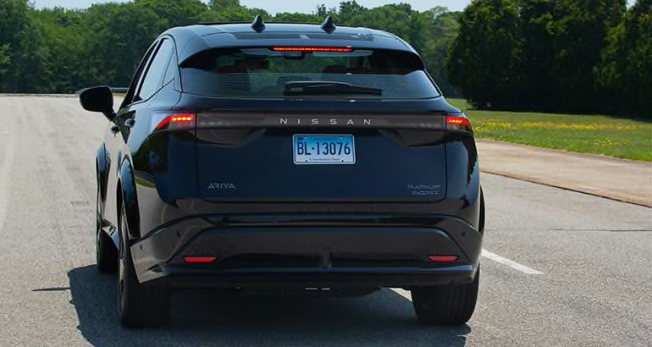
Photo: John Powers/Consumer Reports Photo: John Powers/Consumer Reports
It should be noted that the brake lights also don’t illuminate when the driver of a conventional vehicle with a manual transmission downshifts a gear or two to help slow the vehicle. Nor do the brake lights illuminate if you were to downshift a vehicle equipped with an automatic transmission—via the gear selector or steering wheel paddle shifters—to help reduce speed.
The European Union has a regulation that requires EVs to illuminate their brake lights anytime the regenerative-braking system’s deceleration rate exceeds 1.3 meters per second squared, or about 0.13 g.
After we contacted the National Highway Traffic Safety Administration for comments and clarification on CR’s findings, a spokesperson responded that “Federal Motor Vehicle Safety Standard No. 108 . . . does not require the [stop] lamps to be activated at a specific level of deceleration.” The spokesperson also said that “. . . the agency will be discussing these stop lamp issues with the respective manufacturers during their regularly scheduled meetings with NHTSA. NHTSA currently does not have any open rulemakings to establish a new requirement on this topic.”
William Wallace, CR’s associate director of safety policy, says the need for action is immediate. “This issue clearly increases the risk of rear-end crashes and people getting hurt on our roads,” Wallace says. “The National Highway Traffic Safety Administration should press companies to ensure their vehicles’ brake lights send a clear signal about whether they’re slowing down. Further, NHTSA should update its safety standards to make it clear that the brake lights must illuminate when a car slows down at a certain rate.”
Issues With Mercedes-Benz EVs
In the process of our EV brake-light testing, we uncovered another potential safety issue with some electric Mercedes-Benz models: When the Strong Recuperation regenerative-braking mode is engaged (which is Mercedes’ term for its one-pedal driving), the brake lights on the vehicles we tested turn off as the vehicle comes to a complete stop. Initially, after the driver steps off the accelerator pedal in Strong Recuperation mode, the brake lights illuminate when deceleration reaches about 0.15 g. Then, as the speed drops down to about 5 mph—and as the vehicle reduces its deceleration rate to smooth out the stop—the brake lights suddenly turn off. They remain off for more than 15 seconds, which is long after the vehicle has stopped. They illuminate again automatically after about 15 seconds.
“In the interest of safety, we think a vehicle’s brake lights should stay on while the vehicle is stationary—as if the driver has their foot on the brake pedal,” says Knizek at CR’s Auto Test Center. “This makes the car more visible to vehicles approaching from behind and indicates that the driver intends to remain stationary,” he says.
The vehicles that exhibited this behavior, all purchased as part of CR’s regular test program, are:
- 2022 Mercedes-Benz EQS 580 4Matic
- 2023 Mercedes-Benz EQS SUV 450 4Matic
- 2023 Mercedes-Benz EQE SUV 350 4Matic
- 2023 Mercedes-Benz EQE 350 4Matic sedan
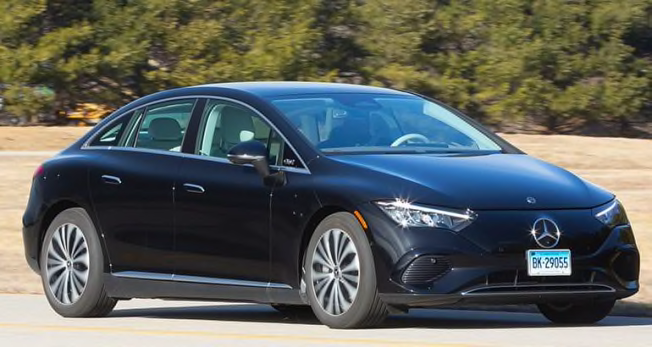
Photo: John Powers/Consumer Reports Photo: John Powers/Consumer Reports
When we queried the German automaker about the brake lights on its EVs turning off as the vehicles come to a stop, Cathleen Decker, Mercedes-Benz product and communications public relations lead, responded: “The brake lamp control is not a design element. It functions in compliance with regulations. Brake lamps are not required to illuminate while the vehicle is stationary and the brake pedal is not depressed.”
CR’s Knizek recommends that drivers of the affected Mercedes-Benz models use only the No Recuperation and Normal Recuperation modes to avoid the issue. “If a driver still wants to use the Strong Recuperation (one-pedal driving) mode, they should make certain that they press and hold the brake pedal themselves once the car comes to a stop,” Knizek says.
Editor’s Note: This article, originally published June 9, 2023, was updated June 16, 2023, with a statement from Hyundai, indicating that it will be making updates to the brake-light logic of Hyundai and Genesis EVs to improve the brake-light response. It was updated again on June 26, 2023, indicating that Hyundai/Genesis and Kia are working on a solution to be deployed to Hyundai, Genesis, and Kia EVs this summer.

















